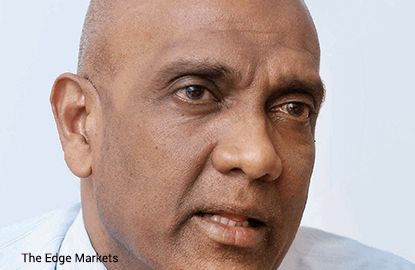
This article first appeared in The Edge Malaysia Weekly, on March 21 - 27, 2016.
HIBISCUS Petroleum Bhd could finally see some earnings visibility with the recent completion of its acquisition of the Anasuria cluster of oil and gas producing fields, which will contribute instantly to its revenue.
Located in the North Sea, about 175km east of Aberdeen, the UK, this cluster comprises four oil and gas producing fields and considerable infrastructure, which includes the Anasuria floating production storage and offloading facility.
Anasuria has proven and probable (2P) oil reserves of 40.4 million stock tank barrels and 2P gas reserves of 27.9 billion standard cu ft, and at the current production rate of its fields, Hibiscus would net 4,000 barrels per day.
The 50% stake that Hibiscus bought in the Anasuria cluster from Shell UK Ltd, Shell EP Offshore Ventures Ltd and Esso Exploration and Production UK Ltd cost US$52.5 million (RM199.1 million at the time). The asset is believed to have a lifetime of 16 to 20 years.
To manage the asset, Hibiscus has set up a joint venture in the UK — Anasuria Operating Co Ltd (AOC) — with its 50% partner Ping Petroleum Ltd. With the completion of the acquisition, AOC becomes the licensed operator of the Anasuria cluster while London Stock Exchange-listed oil and gas service provider, Petrofac, has been appointed the duty holder to operate the oilfields under a US$250 million contract.
Describing it as a “landmark deal” for Hibiscus, managing director Dr Kenneth Pereira says Anasuria, which started production in 1996, is generating positive net cash flow and is profitable even in the current low oil price environment.
Since Hibiscus took economic control of the asset on Jan 1 last year, its net cash flow has been more than US$25 million, which is sufficient to fulfil the company’s share of the transaction. In fact, Pereira says some US$25.7 million has been settled from the funds accumulated from the asset since Jan 1 last year.
According to him, there are three components in Hibiscus’ portion of the US$52.5 million transaction. The first is a US$4.3 million deposit, followed by US$25.7 million, both of which were paid upon the completion of the acquisition. The remaining US$22.5 million is due and payable as a deferred consideration from March 10 next year. The first tranche of US$15 million is to be paid in March 2017, followed by another US$7.5 million six months later.
“Shell and Exxon (ExxonMobil) are very stable owners. We are a small company and we are interested in enhancing production. For us, Anasuria is our top priority as it is our only asset that is revenue-generating,” Pereira says. “We will be looking at every cost line, every activity, to make sure we optimise everything.”
He explains that the cluster’s previous owners, Shell and Exxon, had lost interest in it after its oil production fell from an initial 40,000 barrels per day.
Hibiscus has yet to record a full year of profit. When asked if the company could turn around in its financial year ending June 30, 2016, he says it will record an operating profit. He points out that the average cost of production at Anasuria for the next five years would be lower than US$30 per barrel. However, over a 10-year time frame, this could be lower than US$40 per barrel. This is because as the production of the oilfields declines over time, the cost per unit rises.
“Our earlier projection was the mid-US$30s. So, the current oil price of about US$30 to US$40 per barrel is good for us,” Pereira says, adding that the company will familiarise itself with the operations in the first year of taking over the asset. “The second year onwards, we will look at production enhancement.”
Should there be a need for capital expenditure, the company will look at refinancing Anasuria or raise funds within the JV, he says, adding that there is exploration potential in the cluster.
At some point in time, the company will raise money from its shareholders to have a small financial buffer of US$3 million to US$4 million for the North Sea operations.
Previously, Hibiscus has announced five rounds of private placement since its listing but two of them have been discontinued.
Hibiscus’ share price has been on a downward trend since hitting an all-time high of RM2.74 on Dec 13, 2013. In the past 12 months, the counter has traded in a 13 sen to 91 sen band. It closed one sen or 4.76% higher at 22 sen last Thursday, giving the company a market capitalisation of RM242.61 million.
In 1HFY2016, the group’s net loss jumped almost eight times year on year to RM159.42 million. The only SPAC graduate on Bursa Malaysia, Hibiscus saw its net loss balloon to RM164.17 million in 2QFY2016 from RM10.66 million a year ago, mainly due to a RM84.5 million impairment on the carrying value of the VIC/P57 permit in the Bass Strait in Australia. It is worth noting that some RM56 million of the losses were attributed to the purported dilution of its qualifying asset Lime Petroleum Plc’s interest in Lime Petroleum Norway AS (Lime Norway) and of Lime Petroleum Ltd in Masirah Oil Ltd.
While things seem to have turned for the better for Hibiscus, a dispute with Rex International Holding Ltd — its co-shareholder in Lime Plc — has raised concerns about its earlier investment in the latter.
Hibiscus says it is “aggressively pursuing claims” against three directors of Lime Plc for breach of trust and/or breach of fiduciary duty, particularly with regard to their conduct related to the purported dilution of interests.
Hibiscus’ exposure in the Middle East and Norway is through Lime Plc and its subsidiaries’ oil and gas concessions in these areas.
Save by subscribing to us for your print and/or digital copy.
P/S: The Edge is also available on Apple's AppStore and Androids' Google Play.